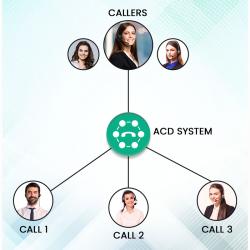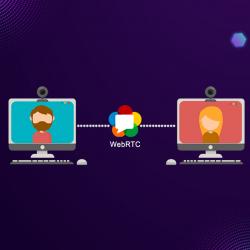Blogs Archive
New blog posts

Things Everyone Should Know About Automatic Call Distribution (ACD)
20 September, 2023 by Vindaloo Softtech Pvt. Ltd.
When managing a contact center or...

Why Should Enterprises Consider WebRTC Client Solutions?
17 August, 2023 by Vindaloo Softtech Pvt. Ltd.
Businesses can’t afford to compromise on...

What is WebRTC and How Does It Work?
1 August, 2023 by Vindaloo Softtech Pvt. Ltd.
The recent pandemic forced businesses to adopt...
HTML block #1
You can change this block in admin panel. Remember, if you change template, this block will be lost. We advise you to clone this block.
Ne lorem percipit efficiantur mei, ius ut simul vidisse. An vel probatus explicari appellantur. Has et comprehensam interpretaris, quo no inimicus maluisset temporibus. Ea mea quod.
Things Everyone Should Know About Automatic Call Distribution (ACD)
Posted on 20 September, 2023 by Vindaloo Softtech Pvt. Ltd.


When managing a contact center or handling the customer service department, you are not unknown to the sheer volume of calls coming in and going out in a single instance. As soon as an agent completes a call, the next call in waiting is automatically routed to them, and this is all thanks to the automatic call distribution mechanism. The primary purpose of an automatic call distributor is to route incoming calls to contact center agents or employees with specific skills. However, contact center owners and admins can make necessary changes to the distribution logic to increase the call processing efficiency of their teams.
Here is everything you need to know about Automatic Call Distribution.
How does Automatic Call Distribution Work?
The Automatic Call Distribution is designed to eliminate unnecessary call transfers, prevent extended customer hold times, and increase first-call resolution rates by automatically connecting customers to the agent most qualified to assist them with their specific issue. It relies on a routing engine that screens incoming calls based on pre-determined parameters. Based on the skills, customer data, real-time contact center performance, customer sentiment, and artificial intelligence (AI)-powered behavioral profiles, the engine automatically matches the customer to the correct agent in the least amount of time.
You may confuse ACD with another integral call center tool, i.e., the Intelligent Voice Response (IVR). While both are integral to business telecommunications and connect the users to the right department or contact center agent, the intent and mechanism is different. IVR uses guided responses from the user to connect them to the correct agent and allows the callers to solve their own issues over the phone. However, an ACD system can make use of inputs from an IVR to collect necessary information for the redirection.
Read more about the basics of IVR and its Importance in VoIP Communications.
The different factors on which an Automatic Call Distribution routes incoming calls are:
- The dialed extension number (the caller is calling sales, support, or feedback extension)
- Area code
- Caller ID
- Time of day
- Client status (VIP, Premium, Regular)
- Any IVR option selected
- Database entry
- Queue Statistics
- Agent Availability
- Agent Skills
The Call Distribution can be any of the following ways:
- Sequential Call Distribution: The calls are distributed in a pre-defined order to all agents for every new call. If the first agent is busy, the call is forwarded to the next in sequence until an available agent attends to the call. This routing method is effective when the top agents are busy, and the callers need to be kept engaged.
- Round-robin (Circular) Call Distribution: The next call is routed to the next in sequence after a previous call is attended. The call is directly connected to the available agent in this routing method as per the sequence. Only after the last agent has taken a call is the sequence repeated.
- Uniform Call Distribution: The least active agent is forwarded the next call. This way, the workload is divided among the call agents and allows the calls to be distributed uniformly.
- Simultaneous Call Distribution: The call is sent to all the agents, and the first one to answer handles the call. This is, however, effective when all your call agents are of the same skill level.
- Time-based Call Distribution: The ACD in the contact center system uses the pre-input time availability of each call agent to determine the right call route. This is a great way to manage business calls when you have users calling from different geographical locations.
- Score-based Call Distribution: Every call agent receives a score based on their call performance. These scores become the deciding factors and add weight to routing purposes. This way, lesser experienced agents and those starting out are exempted from attending high-priority calls.
- Data-based Call Distribution: The ACD taps into the caller information from the CRM or other tools to determine which agent can better assist a specific caller. This call distribution method is profitable as the experienced call agents can easily manage to upsell or offer upgrades to the callers.
What are the Features to look for in an Automatic Call Distribution system?
Callback Scheduling
In a scenario where no call agents are currently available to take the call immediately, you can’t have your callers stay on hold for any longer than a minute without taking a chance of losing them forever. With automated callbacks, a caller doesn’t need to wait to get the best quality help. They often are presented with an option to select a preferred date and time for their callback.
Voicemail Notification
In addition to callback scheduling, having a voicemail in place is important. Callers can record a short message informing their pain points and the call agents can callback equipped with the correct information or solution. Features like voicemail notifications, voicemail-to-text, and voicemail-to-email ensure that call agents are on top of their communication.
Intelligent Call Queing
Your ACD would require a call queuing feature depending on the routing methods implemented. Call agents can view the calls they have in waiting and manage their call workflow to reduce the call churn accordingly. Admin can review the call queue history to add/remove agents to better manage call traffic. Call agents can add VIP or blacklist tags to prioritize certain calls.
Call Monitoring
Call monitoring is vital to improve the agent training process and allow managers to assist agents in real time. In addition, to listen ongoing calls, managers can ‘barge’ in when the call might derail to offer instant support and a higher level of customer assistance.
3rd Party Integrations
Businesses already use multiple business software programs for everyday operations. You simplify the communication process by allowing integrations with your CRM, IVR system, email marketing platform, and your agents don’t need to spend time learning new systems.
The Benefits of Automatic Call Distribution
Having highly customizable call paths and call routing options doesn’t just help to prevent call center agent burnout and increase efficiency.
Additional automatic call distribution benefits include:
- Streamlines communication
- Higher first call resolution rates
- Lowers operating costs
- Improves customer experience and higher customer satisfaction rates
- Fully optimizes workforce
- Faster customer resolution times
- Fewer lost customer support tickets and requests
- Shorter hold times for customers
- Increases employee flexibility/empower the remote workforce
- More personalized customer experience thanks to CRM integration
Wrapping Up
Automatic Call Distribution systems offer contact centers with a wide range of features that can easily boost agent productivity and customer satisfaction. Yet, they are not an autonomous tool and needs to be connected to your contact center software to function. Alternatively, you can go for a solution that offers ACD as one of its core features, such as the contact center solution developed by Vindaloo Softtech.